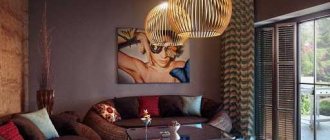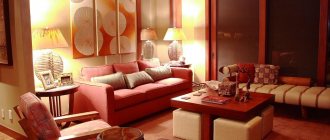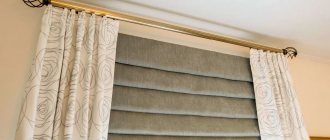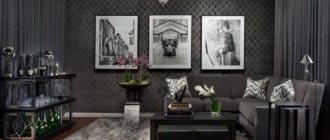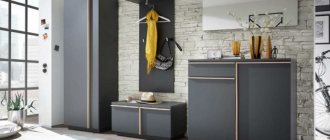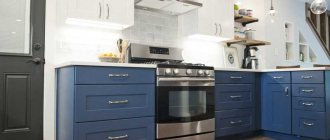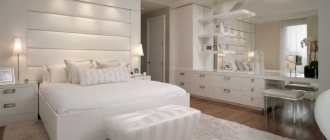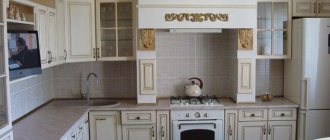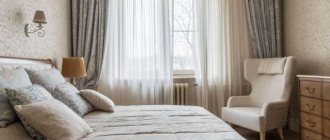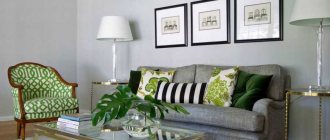All photos In the photo: Interior of a Baroque living room in an apartment The elegant, elaborate and pompous Baroque style, which came to Central Europe from Italy in the 17th century, and became especially popular during the time of Louis XIV, impresses with truly royal luxury.
All photos In the photo: Baroque bedroom in shades of delicate greenery
Versailles, Schönbrunn, Peterhof - the splendor of these palaces is timeless and today amazes the imagination no less than 300 years ago.
Gilded stucco molding, marble, silk carpets, antique furniture made of walnut and rosewood, crystal chandeliers, multi-layered textile decor - a baroque interior is always exclusive and very expensive. Therefore, it is chosen by wealthy and respectable people with a developed sense of style, for whom the home furnishings are not only a demonstration of aesthetic preferences and fine artistic taste, but also an indicator of status.
All photos
How to create a living space in the spirit of Versailles and at the same time in tune with the interior trends of the 21st century? We will talk about this and much more in this review with a selection of photographs from the portfolio of the Studio of Angelika Prudnikova, the leading company in Russia for interior design in the luxury segment.
Characteristics and history
Baroque in the interior is similar to Rococo, an offshoot of the classical style of the early 18th century, which emphasizes ornamentation, mythological themes, and an abundance of decorative elements. The Baroque interior is characterized by contrasting colors, jewelry and graceful gold inserts and decoration.
Features of Baroque in the interior:
- the presence of paintings, frescoes;
- gold trim and fittings, complex patterns and sculpting;
- solid wood furniture;
- large space;
- expensive and voluminous textiles;
- symmetrical arrangement of furniture.
Availability of paintings
The style is distinguished by a large number of candelabra, curls, and gilding. If you choose among the replicas, then you should pay attention to the following.
- Death of Mary.
- Exaltation of the Cross.
- Jewish bride, etc.
All of them are distinguished by muted tones, large forms, and uniform motifs. You can also find a decent option from contemporary artists.
Natural materials
Everything here is quite simple, you need to remember that the movement dates back to the Middle Ages, when people did not yet know about plastic. Only natural materials are used.
- Stone.
- Tree.
- Cotton, linen, leather, velvet, skins, fur, etc.
Tables, chests of drawers, shelves should be made only from expensive and high-quality wood. If we consider ideas with decoration in the style of Italy of the 17th century, then we definitely need to provide candlesticks made of high-quality metal.
Large space in the room
Many may think that a Baroque apartment implies “clutter.” However, this is not the case. The style has a mirror character, which should only visually increase the space. Examples can be seen in the collected collection.
Symmetry of interior furniture
Experience has shown that only a single style can support ergonomics. For example, a chest of drawers and a closet should not be decorated in different styles or colors. Everything must be holistic and unified; this is the only way to maintain the fine line between “compressive” space and spaciousness.
Modern furniture, which is 90% custom-made, removes the feeling of “bulkyness”.
History of origin
It appeared towards the end of the 17th century, first in Rome, and later took root in Venice and Florence, after which it conquered all of Europe. The Baroque style in the interior came into fashion under Louis XIV, the peak of its popularity was the 18th century, and now there are also a considerable number of adherents of this trend.
The premises, decorated in the Baroque spirit, are reminiscent of royal palaces, replete with expensive ornate decoration, everything here is large-scale, intricate, even deliberately flashy. Initially, the unusualness and whimsicality of this trend were put at the service of noble persons and high-ranking ministers of the church in order to emphasize their wealth and power. Therefore, any element of furniture or decor pathetically declared the wealth of the owner.
The beginning of the Baroque era was the end of traditionalism and adherence to the classics. In the interior, as in all other areas, lush and extraordinary forms, dynamism, and contrasting color schemes are welcomed.
The emergence of the Baroque style
At the beginning of the 17th century, religion in Rome played a huge role in the lives of ordinary citizens. In response to the Protestant Reformation, the Catholic Church sought to establish emotional contact with the Italians. And if during the Renaissance, architectural art positioned itself as elitist and “not for everyone,” then the Baroque was designed to make even the uneducated masses believe in the power and grandeur of the church.
The popes hired the best architects, artists, and interior designers to build countless churches and palaces, which changed the appearance of the city and made Rome visually richer and more luxurious. This style was quickly picked up throughout Europe. Following the exterior, the interior decoration of wealthy citizens also changed.
The great artists of their time were developing a new style of furniture and decor, trying to outdo each other and themselves. Let's see what they came up with.
Furniture
During the Renaissance, when the direction was just emerging, the shapes of sofas and armchairs underwent some changes. They began to use embossed leather and velvet for upholstery, the backs and legs became curved, and the seat lengthened so that legs could be placed there. Wooden surfaces with a matte, rough surface began to be treated with varnish and gilding.
Fashion is replenished with such a concept as a furniture set; the nobility ordered furnishings from eminent craftsmen. Tables with mosaics and chairs with artistic carvings were made by hand, huge beds were erected on a podium and decorated with canopies. Lying in bed, the nobleman sometimes received guests, so its headboard was also decorated with openwork details, gilding, and draped curtains.
Baroque style furniture is characterized by:
- carved details decorated with gilding;
- the backs are high, curved;
- use of expensive stone, valuable wood species;
- painting and gilding;
- use of silk and velvet, hand embroidery.
How to create a design correctly
The Baroque style, like a mosaic, consists of many details. All surfaces in the room are used, otherwise the design will be incomplete. There are rules to help recreate luxurious interior design.
Walls
The main goal of baroque is to surprise those entering the room. The decoration of the vertical space is chic and luxurious. The walls should not be monochromatic or covered with the same type of material. The design combines voluminous and smooth surfaces, contrasting gloss and matte.
Palace luxury is recreated with the help of modern decoration. Decorative plaster is used on the walls, which visually repeats the pattern of the stone. Solid color inserts will add relief to the surface:
- curbs;
- moldings;
- pilasters;
- stucco.
Often the walls are divided into rectangles and filled symmetrically with 2-3 types of materials. Tapestries on a textile or paper basis will add dynamics to the Baroque style in the interior. Instead of plaster, you can use “liquid” or vinyl wallpaper, creating the desired volume and texture.
Wooden or plaster panels painted to match the main background will help outline the boundaries.
The luxury design of technical premises is no different from residential ones. Ceramic tiles are appropriate on kitchen walls. In the apron area, a mosaic or fresco is used, hidden under thermal glass. When decorating a bathroom, they emphasize the beauty of the natural texture of the stone, combining the play of gloss and matte.
Floor
Baroque flooring is distinguished by palace luxury. Even if the walls are done in muted colors, the floor will be bright and noticeable. Designers use natural materials:
- noble wood;
- granite;
- marble.
Artistic parquet is appropriate as a covering in the living room. The combination of different types of wood allows you to get an unusual texture or color; they combine varnish and matte muting. Using the material, they create huge paintings on the floor, emphasizing the size of the space.
In modular (“panelboard”) parquet, the dies are assembled in the shape of a rectangle. The covering visually resembles a carpet. The rosette variety looks luxurious, the pattern of which is concentrated in the form of a circle in the center of the room. When dividing a room into zones, decorative border trim is applied. If you need an aged effect, craquelure technology is used on the floor.
When decorating a Baroque style in a bedroom interior, designers use varnished boards. The glossy shimmer of the finish enhances the beauty of the wood. The space looks luxurious, expensive and elegant. The covering is often complemented by a carpet with a geometric pattern.
In a Baroque interior, a self-leveling floor looks impressive. The decoration will harmoniously fit into the living room and bedroom, bathroom and kitchen. The wear-resistant material can visually resemble parquet with a complex pattern or precious stone. The pleasant, warm surface can be glossy or matte.
Ceiling
When designing the overhead space, the luxury of the design is emphasized. Both classic flat structures and complex types (spheres, vaults) are appropriate in the interior. The high ceilings are decorated with paintings and ornate stucco moldings. Decorative elements flow onto the wall, creating a single composition.
Overhead you can combine different technologies. Designers combine multi-level plasterboard structures with tensioned fabrics.
The huge ceiling reproductions, repeating the scenes of famous masters, look impressive. A voluminous border is placed around the perimeter, and cherub figures are placed in the corners.
A fresco will harmoniously fit into the design of a baroque room. Based on the type of image application, there are 3 types:
- Wet plaster. Traditional technology makes it possible to obtain original drawings.
- Canvas. The painting is fixed on the ceiling, the edges around the perimeter are hidden under the frame.
- Non-woven fabric. The fresco is printed on wallpaper and then glued to the surface. The textured material visually resembles raw plaster.
An image that completely covers the space above your head looks luxurious. The huge pattern emphasizes the height of the ceiling and the size of the room. Designers often create the effect of a remote retrospective. In the bedroom, frescoes “inscribed” in ovals or rectangles are appropriate.
Windows and doors
The monumentality and pomp of the baroque interior is emphasized by the huge openings. Large glass blocks are often made in the form of arches. Stucco molding is placed around the perimeter of the wooden frame, which echoes the design of the ceiling.
The glass surface is supplemented with sprats. The decorative frame on the windows visually resembles a lattice.
In a Baroque interior, elegant doors with a straight or arched opening are appropriate. Hinged double-leaf structures with carved or stucco facades look impressive and are suitable for country houses. Interior options in the apartment consist of one element, complemented by stained glass windows.
Wall decoration
They cannot be monochromatic. Volumetric details in the form of moldings and borders must be present. Decorative plaster, textile-based wallpaper, wooden panels, and niches are welcome.
At the dawn of the style, the walls were decorated with paintings of religious and battle scenes, tapestries, and brocade. Today, the design uses stylization of ancient engravings, and there are scenes on the theme of city panoramas and travel.
The luxury of the decoration can be emphasized by mahogany or rosewood panels, paintings in the Renaissance style, decorating the room with pilasters and complex stucco.
When decorating the walls, they do not use one type of material, there must be several of them, they must be expensive, compatible with each other, additionally decorated with decor that can delight any guest.
Accessories
Decorative items for the Baroque style in the interior are selected especially carefully. With such an abundance of stylish accessories, each item needs to be included so that the house does not look like an antiques store, but looks luxurious and harmonious.
Mirrors in gilded inlaid frames, figurines and boxes, candlesticks and paintings on the walls will add sophistication and aristocracy to the interior.
Fresh flowers and arrangements in designer vases will be appropriate in any home. A luxurious carpet made of silk or wool will harmoniously fit into the created interior.
This elegant and pretentious style with graceful lines and rich pompous decoration, as a reminder of palace interiors, is still interesting today. Of course, it is difficult to create a full-fledged Baroque interior for a number of reasons, but some elements of this elegant and romantic style will appeal to lovers of richly decorated interiors.
Wall decoration
The main rule is that the walls must be embossed. The Baroque style involves dynamics: a huge number of inserts, borders, moldings, tapestries, stucco moldings, niches, columns, and even pilasters. Renaissance paintings on the walls are welcome. Textile wallpaper, plaster, and painted wood panels are also used to add volume. Feel free to mix decor with each other: stucco, gilding, frescoes - in this style there is no such thing as “too luxurious”.
Choosing color shades when decorating and renovating an apartment in the Baroque style
There is a certain stereotype that baroque is only burgundy and purple shades. It is important to remember here that each country has its own characteristics and folk trends. Therefore, it is necessary to explore the options described below.
White
Speaking of white tone, here we can highlight shades that are more like ivory. Maintaining whiteness in the 17th century was very problematic. In combination with gilding, one can highlight the aristocracy of the owner. Examples can be seen in the photo.
Important! Baroque in the interior of an apartment in white looks very modern.
Gold
Sand walls, terracotta details - all this can increase the cost of housing several times. Despite the fact that many consider the predominance of such a palette to be something vulgar, if the designer works correctly, everything will look harmonious and fresh.
Blue
The use of dark shades is expected. In this case, it is advisable that the apartment is located on the sunny side, otherwise the housing will be plunged into darkness. The situation can only be saved with the use of pre-thought-out lighting engineering.
Violet
A classic for connoisseurs of the origins of this movement. In 2021, Dolce and Gabbana were able to give this trend new life. You can familiarize yourself with the current palette and the correct play of light in ready-made examples of projects and ideas.
Pink
A real paradise for women who have dreamed all their lives of taking the place of a queen or princess. If you play with the palette correctly, you can recreate the classic Baroque. Well suited for highlighting a nursery in a two-room apartment.
And others
Brutal black baroque for real men and hunters. The interior should be dominated by real leather and expensive wood. It is recommended to make the room on the sunny side, otherwise even lighting will not help. Brown shades that were fashionable back in the early 19th century.
Look great with modern technology and art objects.
Story
This is a protest style. It began to take shape in Italy in the 16th and 17th centuries, against the backdrop of attempts by foreigners to dictate their terms of development to this state. At first, the direction was perceived as something ridiculous, strange and bizarre. Noble Italians collected in their homes everything that indicated luxury, their superiority over the whole world in architecture and art, and the interior turned out to be unusual, often provocative and even frightening in its pomp.
Attempts to impose a foreign culture on the Romans did not lead foreigners to the desired result. Gradually, the former greatness and influence of Rome returned, the style was formed, an understanding of its foundations and main features came, but the tendency towards excess, elitism, and pretentiousness in individual elements remained. The direction remains the same now. It is emphatically chic in everything - fabrics, furniture, decoration. The interior resembles a palace even in a small room. But the slightest mistake in design can lead it astray, making it vulgar and overly pompous. There is no point in trying to create a design project on your own.
Baroque style in a modern apartment interior concept
As noted earlier, each country has made its own adjustments in this direction over several centuries. The features can be found below.
Sicilian Baroque
- To understand the main idea, you should pay attention to the details.
- The room is dominated by natural stone.
- All buildings erected in Sicily in the 17th and 18th centuries are characterized by narrow passages, marble and elaborate staircases.
- Dark tones and shades - from gray to black.
- You need to pay attention to the works of Vincenzo Sinatra.
Portuguese Baroque
The style was influenced by several other countries that arrived as refugees during the 18th century. These are Arabs, Turks, Germanic peoples. Many people attribute this trend to pombalino. Secular pretentiousness, pragmatism. You can see the ideas in the photo.
Russian Baroque
Russian Baroque is more associated with the theater. The main emphasis is on drama, so not everyone can withstand such pressure. Only suitable for certain personality types.
And other
Many may not even realize it, but even small countries have their own distinct style. For example, Moldavian Baroque may seem the most interesting option. Since the territory was filled with the Romanesque movement in the 18th century, it could not pass without a trace.
Expensive and massive decorative items made of gold and art objects are typical here.
Designer tips for organizing lighting in a Baroque apartment
Since the Baroque style is often associated with dramatic motifs, efforts will have to be made to properly organize the lighting. You can see the designers' proposals in the photo. It is also worth noting that only a true professional should work on light distribution.
Baroque is an unusual choice for a modern person.
It is more suitable for creative and wealthy people who value art and luxury. You need to understand that you will have to make a lot of effort to recreate one of the most interesting styles in history.
Baroque in a modern interior
When creating a Baroque style in a modern interior, you need to remember that:
- this is one of the most expensive interiors, which cannot be faked and requires elaboration;
- it is difficult to fully implement it in small rooms and small-sized apartments; baroque needs space;
- Modern finishing materials, such as wallpaper, linoleum or modern stretch ceilings, PVC film, are inappropriate here;
- kitchen appliances, TV and other household appliances must be hidden after use or disguised with front doors;
- you can create a compromise modern baroque style that fits well with modern elements of everyday life.
Baroque is one of the most demanding styles, but even in a small room you can recreate it using not all pieces of furniture, but only elements. Characteristic decor and textiles will highlight the interior and set the mood for guests at home.
Why is it better to entrust interior design to a specialist?
A professional designer perfectly sees the line that separates the luxury of true Baroque from kitsch and does not allow turning a house or apartment into something between the home of a bankrupt aristocrat and a nouveau riche mansion, when designing the main motto: “Only the most expensive.”
The specialist, after listening to all your wishes, will draw up a design for each room, specifying not only the arrangement of furniture, but also the finishing of each surface, and the availability of certain accessories.
How to decorate different rooms?
Each of the rooms in the home can be decorated in a baroque style.
Dining room
It is recommended to install the most beautiful sets in the kitchen and dining areas of an apartment or house. The use of painted furniture (with the inclusion of openwork details) is also recommended. For upholstery, use silk or velvet fabric, preferably with a pattern. To create the most sophisticated interior possible, it is advisable to decorate the space with stone.
Cushions on sofas must be embroidered by hand.
living room
The design of even a small guest room involves the use of large fireplaces with custom finishes and selected textiles. The use of valuable wood is encouraged. Tones are selected with the expectation of emphasizing the depth of space and creating contrast. Experts advise giving preference to burgundy, green, black and white colors.
When renovating, walls, door and window frames are often inlaid; you can also use plaster with stucco inclusions and imitate columns.
The ceiling in the baroque living room is decorated with arches and painted. A crystal chandelier will look gorgeous. It is worth laying parquet on the floor. The floor is also sometimes finished with natural stone or covered with a lush carpet. Decorative items are complemented with fringe, ruffles and bugles.
bedroom
Such a room can be created by:
- decorative plaster;
- plaster moldings;
- paper wallpaper with golden print;
- multilayer ceiling containing warm-spectrum LED lamps.
Wide moldings with pronounced relief are placed at the corners of the ceiling. The floor is decorated with marble tiles or complex inlaid parquet.
Important: the color of all finishing materials must match the overall tone of the room.
Milky, white, beige and light yellow colors are preferred, creating a warm and cozy space. The average bed has dimensions of 2x3 m or even more, complemented by a high soft headboard and an airy canopy.
hallway
The layout of the furniture is thought out so that even when it is completely saturated, there remains quite a lot of free space. Space for accessories is also taken into account. There must be curved lines everywhere. Even a straight decorative column is not as appropriate as its twisted counterpart. Stucco molding is also required, ideally complemented by gilding.
Welcome:
- fresco painting;
- multilayer curtains and draperies;
- an abundance of mirrors;
- bright hues.
A classic baroque office includes round and rectangular tables. The edges are inlaid and decorated with carvings. If you have enough money, you can purchase furniture made of ebony wood. Cabinets can be equipped with steel linings and mosaics.
A good office includes chests of drawers, desks and coffee tables, sofas, chairs and armchairs.
Children's room
Such a room, when decorated in the Baroque style, has pale pink or blue colors (in all possible shades). In addition to painting the walls, these colors are used in decorating other parts of the room. Color is also created using the already mentioned golden and white paints.
The essential features will be:
- the presence of a canopy;
- use of lace;
- hanging paintings in the Rococo style;
- light furniture with abundant carvings;
- themed applications for furniture;
- textiles in soft pastel colors.
Main features
It cannot be confused with other directions. Solemnity and pomp are the main features. All small details should complement each other and form a single whole. The main features of baroque style room decor are:
- Large spaces are being decorated. This style is not suitable for small spaces. In small modern apartments you can use only some of its elements. Furniture and room decor details have characteristic smooth curved lines. The Baroque style uses round and rectangular shapes, vaulted structures, and massive columns.
- An abundance of decorative items. Design in the Baroque style involves the presence of rich voluminous stucco molding, candlesticks, candelabra, massive clocks, figurines in wall niches, fringe and monograms, photo frames.
- The use of expensive finishing materials. The design uses marble, stone mosaics, valuable types of wood, gilding, ivory, and expensive fabrics are present everywhere.
- Thoughtful lighting. Its excess is not welcome. A massive crystal chandelier or gilded multi-tiered lamps, which provide diffused, muted light, will come in very handy.
- The presence of at least one large mirror that reflects this light. A carved frame for it. Gilding.
- Harmonious color scheme. The main color palette of the direction is pastel colors, dominated by white, yellow, blue and their shades, as well as red, burgundy, and green.
Shapes and designs
The Baroque style is characterized by pomp, decorativeness, and theatricality:
- the structures are dynamic and have a complex layout;
- oval, dome-shaped, vaulted shapes;
- flowing lines, smooth, with rounded corners;
- The designs are asymmetrical with protruding and sinking elements.
Colors
The color scheme is created by contrast: gold and white, blue, pink, red, green, blue. Intense shades, from burgundy to emerald, combined with pastels.
Doors and windows
The windows are rectangular or semi-circular, the doorways are arched with columns, directed upward. The frames are made of natural wood, varnished and inlaid.
They are decorated with floral ornaments around the perimeter, carvings, gilding, massive openwork handles, and stained glass.
The windows are draped with multi-layer curtains made of jacquard, gold brocade, silk, and velor. They are decorated with lambrequins, lining of the opposite color, a large number of folds, braid, tassels, fringe, lurex.
Floors
Marble, majolica or natural wood parquet are used to cover the floor.
Walls and ceilings
The walls and ceilings imitate the incomprehensibility of the sky: artistic painting, relief stucco with figures and garlands of flowers flying upward. Ceilings are constructed from multi-level rectangular and dome structures. Three-dimensional sculptures, pilasters, cornices, columns with volutes and gilded trim are used in the design of the walls.
It is recommended to combine finishing materials to smooth out the transitions from the walls to the ceiling as much as possible. The color scheme of the rooms is being thought out: a contrasting combination separating the upper and lower tier.
The decoration uses decorative plaster and textile wallpaper.
Lighting
The lighting is based on the play of light and shadows: candelabra, chandeliers, girandoles, multi-level crystal chandeliers with pendants and curls, lampshades decorated with expensive stones and fabrics, gold leaf, and abundant carvings.
Furniture
Baroque furniture emphasizes the pomp of the interior: armchairs with curved backs and elongated seats, voluminous sofas, poufs and footstools with curved legs and plastic surfaces. It is made from expensive plastic species - southern walnut, Ceylon ebony. Inlaid with gold, silver, bone, marble with images of female figures, heads of lions and rams. The upholstery is bright from natural textiles: velvet, jacquard, tapestry, damask.
Decor elements
When planning, large window and door openings, niches for figured statues and flowerpots are laid out, and the location of mirrors and tapestries on the walls is taken into account.
Large oval and rectangular mirrors are framed in expensive wooden or bronze frames, carved, gilded and mother-of-pearl. Porcelain dishes and vases are distinguished by ornate curved lines and are varnished.
Beautiful examples
The photo shows an attractive baroque style bedroom. The white color is diluted with golden inclusions. Furniture with carved figured legs, decorative pillows and other characteristic decorative elements are skillfully used.
But you can do it differently by using a combination of light and dark tones to decorate a baroque living room.
You can also look at such an example - a kitchen in the Baroque style, where the features of the format are also shown using a white and yellow color scheme and many figured elements.
Lighting
Baroque rooms require large windows that provide plenty of daylight. Wide mirrors are also used to fill the space with light and visually enlarge it. Artificial lighting is represented by massive crystal chandeliers with lamps imitating candles. Wall lamps and spectacular floor lamps with carved legs are also used.
How to decorate the ceiling
Typically, various styles do not include ceiling decoration. But in Baroque, volumetric painting is used based on scenic forms; vaulted or straight ornaments are allowed.
Characteristics:
- Display luxury that has nothing to do with functionality;
- A harmonious combination of an ornate pattern moving from the walls to the ceiling;
- Using elegant decorations for rosettes and chandeliers;
- Adding circles or ovals covered with gold and frescoes;
- Painting or fresco based on distant perspective.
Color in style
Color tones should be rich, most often they use white with gold, or instead of white they use bed tones, such as sand or beige.
Also, the walls can be a dark shade, but at the same time decorated with gold inserts and threads.
